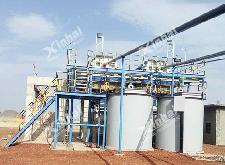

Warm Tip: If you want to know more details about equipment, solutions, etc, please click the button below for free consultation, or leave your requirements!
What are the requirements of ball mill testing, starting and stopping? In which conditions should ball mill be tested and stopped? In this passage, we are going to discuss according to these aspects.

The ball mill tesing is mainly about the new installation equipment or equipment after repairing. Commonly, the test running of ball mill can be devided into three parts:
The preparation stage is mainly to check the tightening of the ball mill motor, electrical appliances and various bolts; Check lubrication, sealing and other measures to confirm whether intact, as well as turning the car to check whether there is any abnormal.
The no-load test can only be started after turning off and there is no abnormal phenomenon. In the absence of any media and materials for idling, and continuous operation of not less than 4 hours, under normal circumstances, the duration of no-load test is 6~8 hours is the best, because the longer the test time, the better meshing of the main bearing, gear tooth surface.
No-load test requirements:
The lubrication of each lubrication point is guaranteed to be normal, no oil leakage;
Bearing temperature shall not be higher than 50℃;
Smooth operation of the ball mill, gear transmission no abnormal no noise;
No loose ball mill lining plate and transmission parts;
When the ball mill reaches the above standard, it can be tested. However, it should be noted that after the test, all working parts of the ball mill should be carefully checked to ensure the normal operation of subsequent production.
3. Test running with load
Load test is carried out after the no-load test is qualified, which is divided into two stages: half-load test and full-load test.
Half-load test run: the filling rate of the medium in the ball mill cylinder is about 20-30%, and appropriate materials and water are given for a continuous test run of 8-10 hours.
Full load test: after the half-load test and everything is normal, add enough medium inside the ball mill cylinder (gradually increase the ore amount) and run at full load for 10~20 hours.
Load test requirements:
The ball mill runs smoothly without noise without periodic sharp vibration;
No loose parts of the ball mill; The main motor current has no abnormal fluctuation;
The lubrication points are normally lubricated and the temperature of the main bearing of the ball mill shall not exceed 60℃.
Ball mill is an important equipment in mineral processing which has large investment. To ensure the normal running of ball mill, we need strictly keep the rule of relative operation, in case of security accident. The rules are as follows:
Before running, ball mill should be checked in detail roundly, excluding all the malfunction which influences running.
The grinding operation part should be started opposite the flow direction of slurry one by one (this part includes the whole grinding system), such as oil pump, to classifier, to ball mill, to belt conveyor, to feeder. The equipment should not be started at the same time.
The starting between each equipment should be intervals. Feeding must be after the starting and normal running for each equipment.
Ball mill stopping can be devided into normal stopping and accident stopping.
The principles of normal stopping includes:
The stopping direction is opposite with starting,such as feeder, to belt conveyor, to ball mill, classifier, to oil pump.
The ball mill needs to stop more than 4 hours, and then turn the cylinder 2~3 rounds before starting again, in order to loosen the cement mud and medium.
The normal stopping should be in empty load condition. It is necessary to clean the material inside the ball mill barrel before parking. It is better to stop the mine for 15~20 seconds after stopping to create good conditions for starting next time.
The principles of accident stopping includes:
Accident stopping refers to the failure of the ball mill due to the failure of the lubrication system, power supply system or the equipment itself, and the failure cannot be discharged under the operating conditions, which requires stopping for inspection and maintenance. What are the conditions that require immediate maintenance?
Collision between feeder and material box, a loud noise or the spoon head off;
The ball mill lining plate falls off or the screw fixing the lining plate breaks, etc.
Transmission gear teeth, issued a greater periodic sound;
Ball mill cut off oil, but not found bearing overheating or small amount of oil can not find the cause;
Anchor bolt broken, cracked, ball mill vibration;
When the temperature of motor, reducer and bearing rises sharply above 80℃;
Electric motor, electrical appliances spark, smoke or abnormal sound;
The main shaft is broken or does not rotate;
When the power supply system fails to discharge barrier when the power is on;
Note: stop feeding the mine and water immediately after the accident, and turn all electrical switches on the stop state.
The above are the relevant requirements and precautions for test, start and stop of the ball mill . If there is no relevant professional to perform a full range of control in the mineral processing plant, this content can be used for reference, but it is recommended that each plant should be equipped with a theoretical personnel can also carry out actual operations.
Last: 4 Steps to Debug Ball Mill
Next: Comparison of Peripheral Transmission Thickener and Center Driving Thickener
121 Factors You Must Know About Ball Mill Liner
 5
5
 9390
9390
2How to do the Ball Mill Repair and Maintenance Work?
 0
0
 3240
3240
32 Factors Affect Grinding Efficiency
 -595
-595
 2777
2777


What Are the Differences Between CIP and CIL?
 11132
11132
 0
0